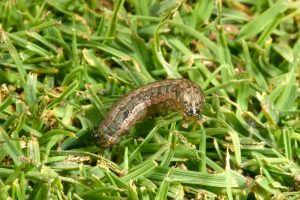Photo courtesy of David Shetlar, Ph.D., Ohio State University.
The larval (caterpillar) stage of the fall armyworm moth can cause serious damage to lawns. In summer, the moths lay clusters of eggs in cotton-like, greenish-white masses on structures (houses, mailboxes, fences, signs, etc.), shrubs and trees, and the newly hatched larvae drop down to the ground and “march” like an army to feed on the closest grass.
While the larvae are still small, damage may not be readily apparent. But when they reach their full size (about 1-1/2” long), they can eat the grass down to the soil. Major infestations can defoliate a lawn entirely.
Lush green grass is the fall armyworm’s preferred food, so irrigated lawns of any type (warm- or cool-season) are at most risk. So are newly laid sod and newly seeded or overseeded lawns, since these must be kept moist/irrigated until the new grass establishes roots.
Controlling fall armyworms is difficult, since several generations can occur in one summer-through-fall season. Products that contain carbaryl (such as Sevin) or pyrethroids will be most effective while the larvae are still small. Mowing the turf and a light irrigation before treatment can increase control. Repeat treatments may be necessary.
